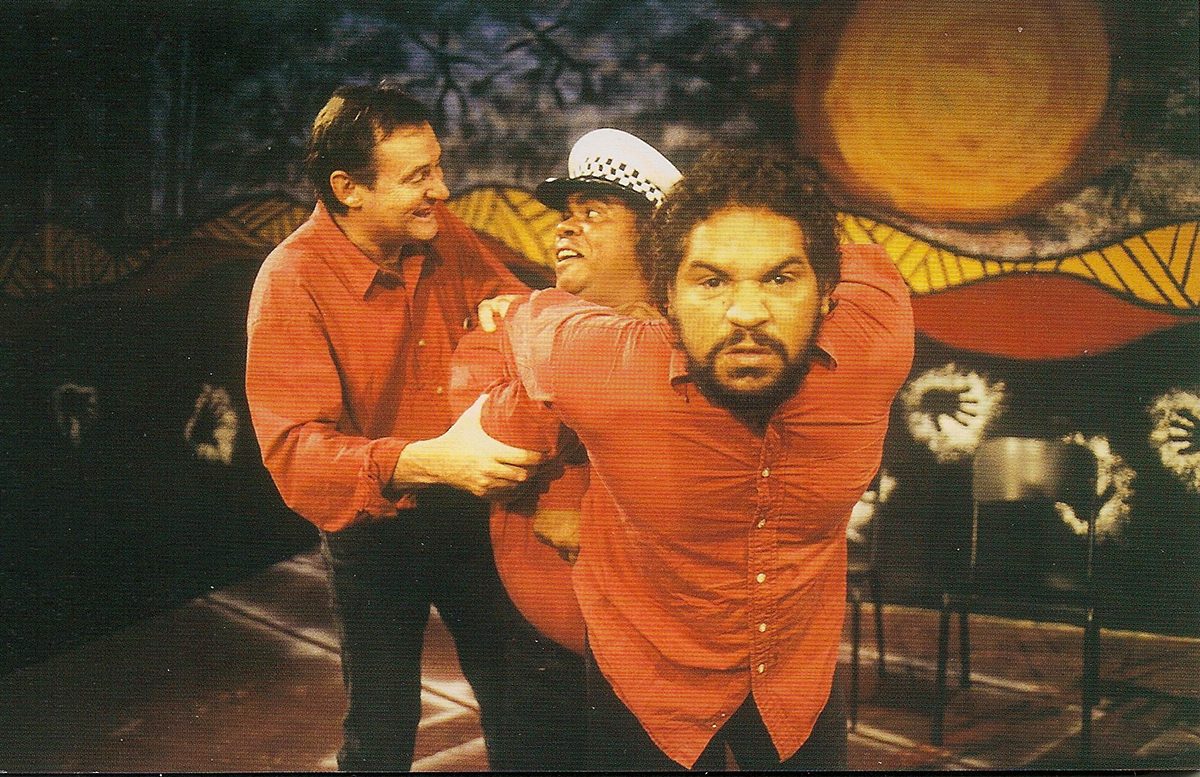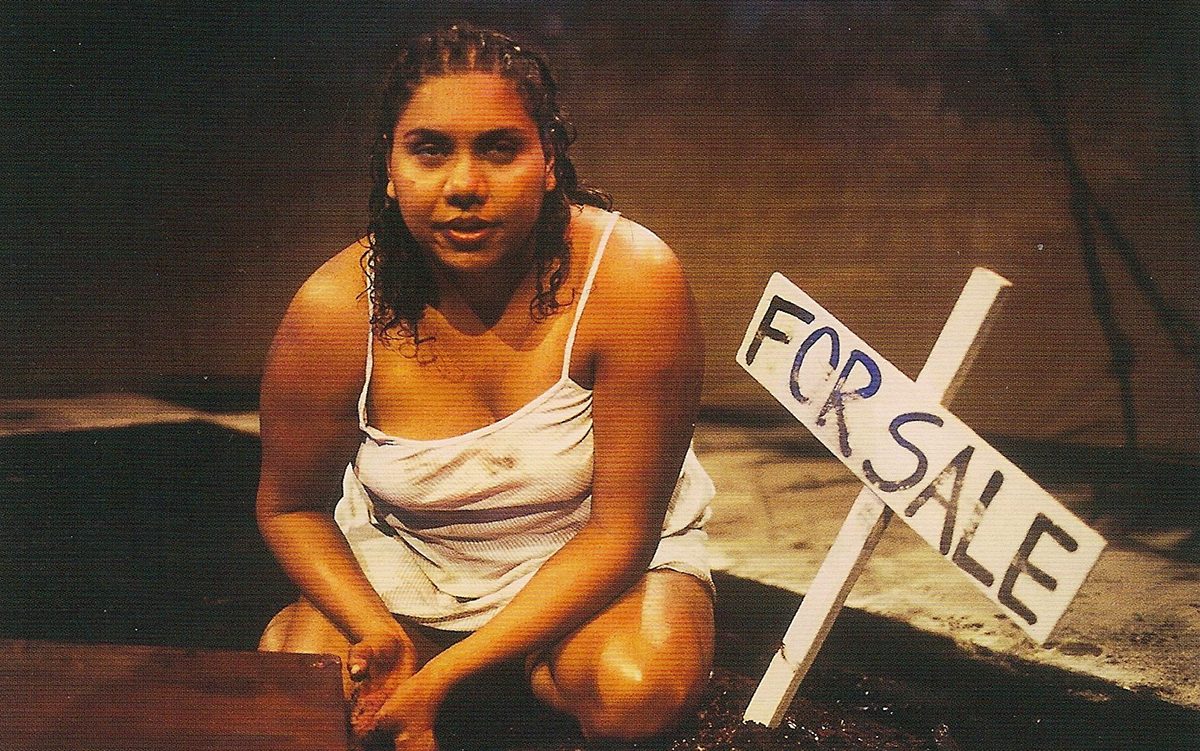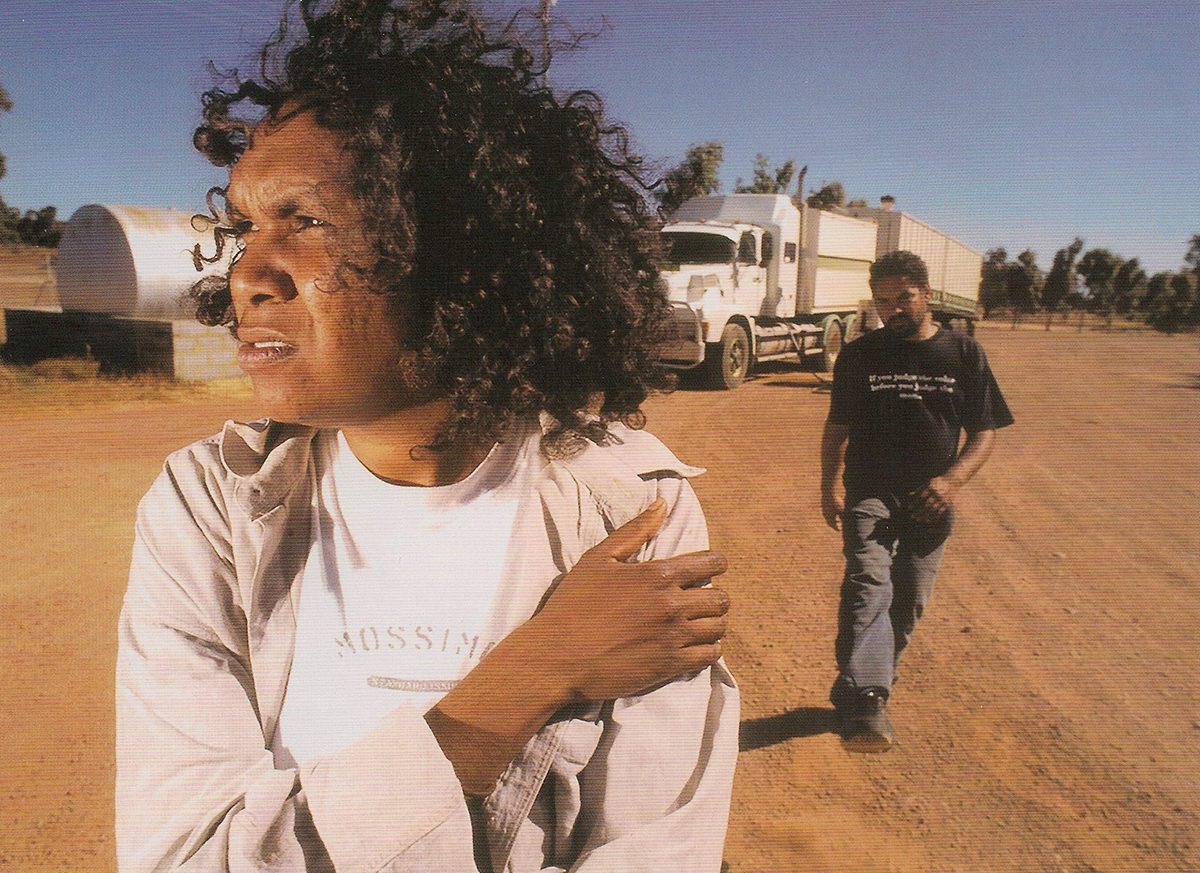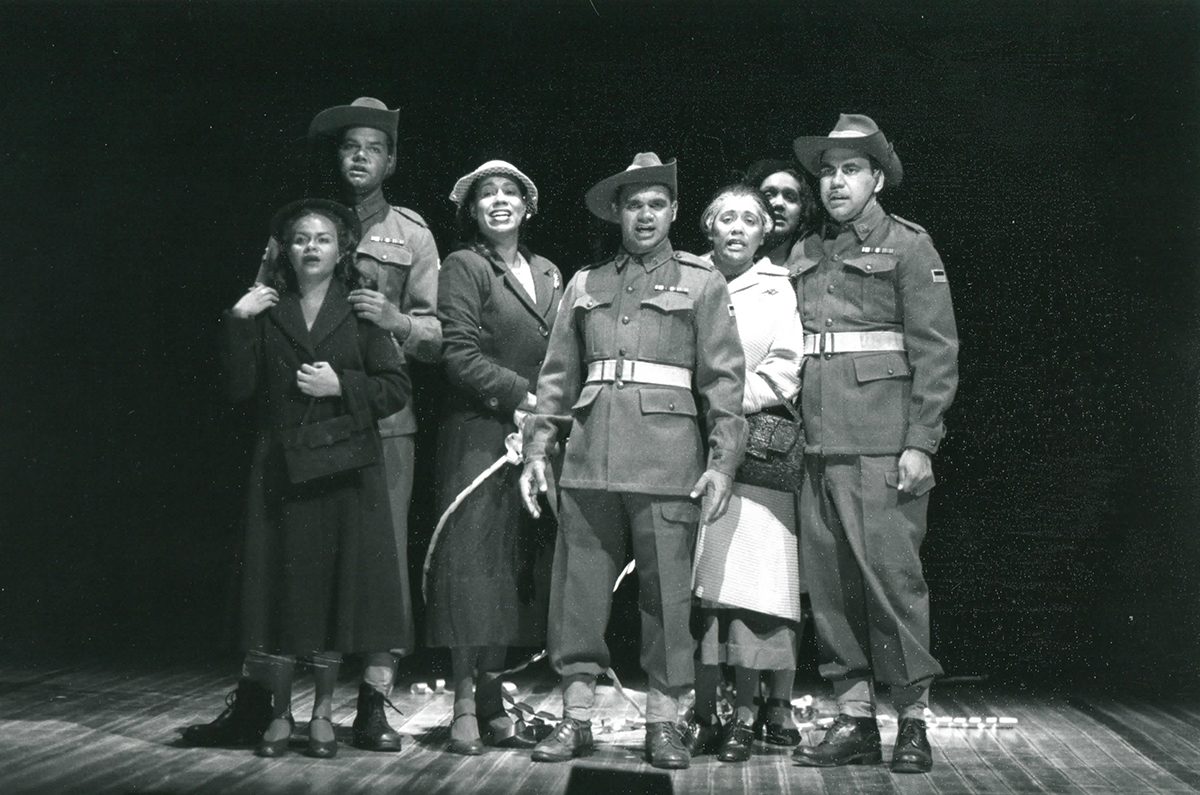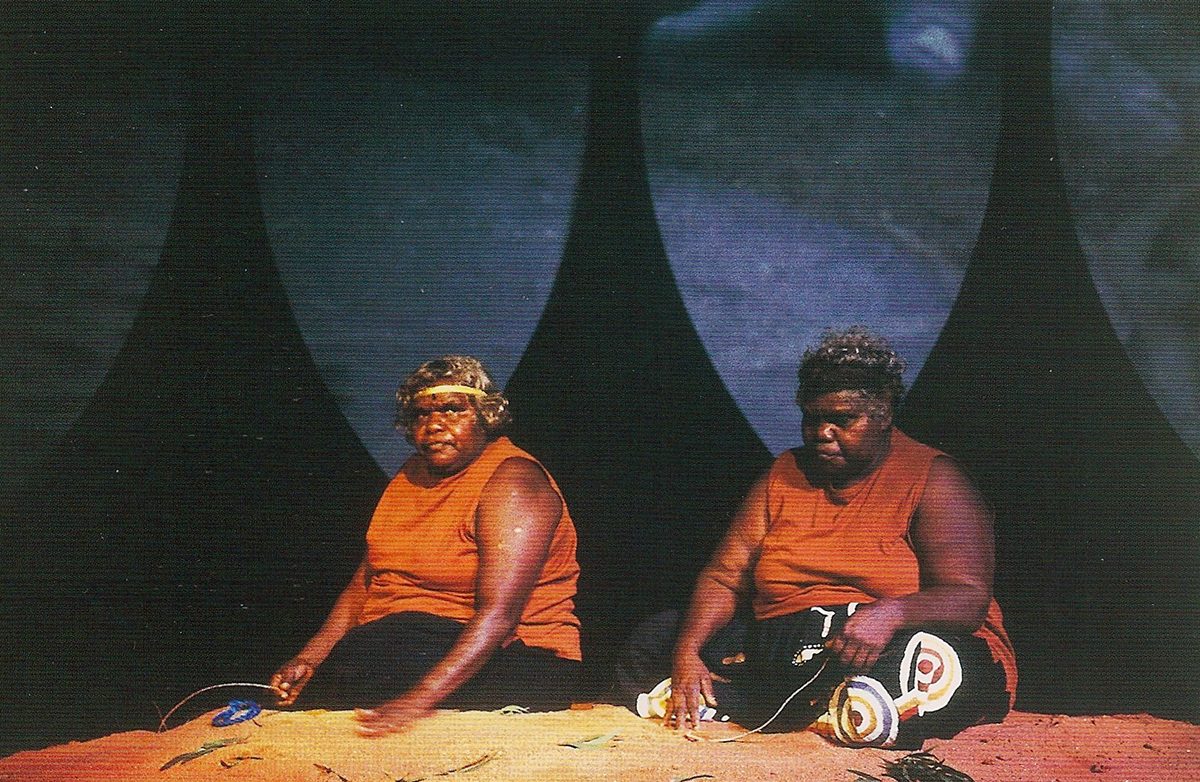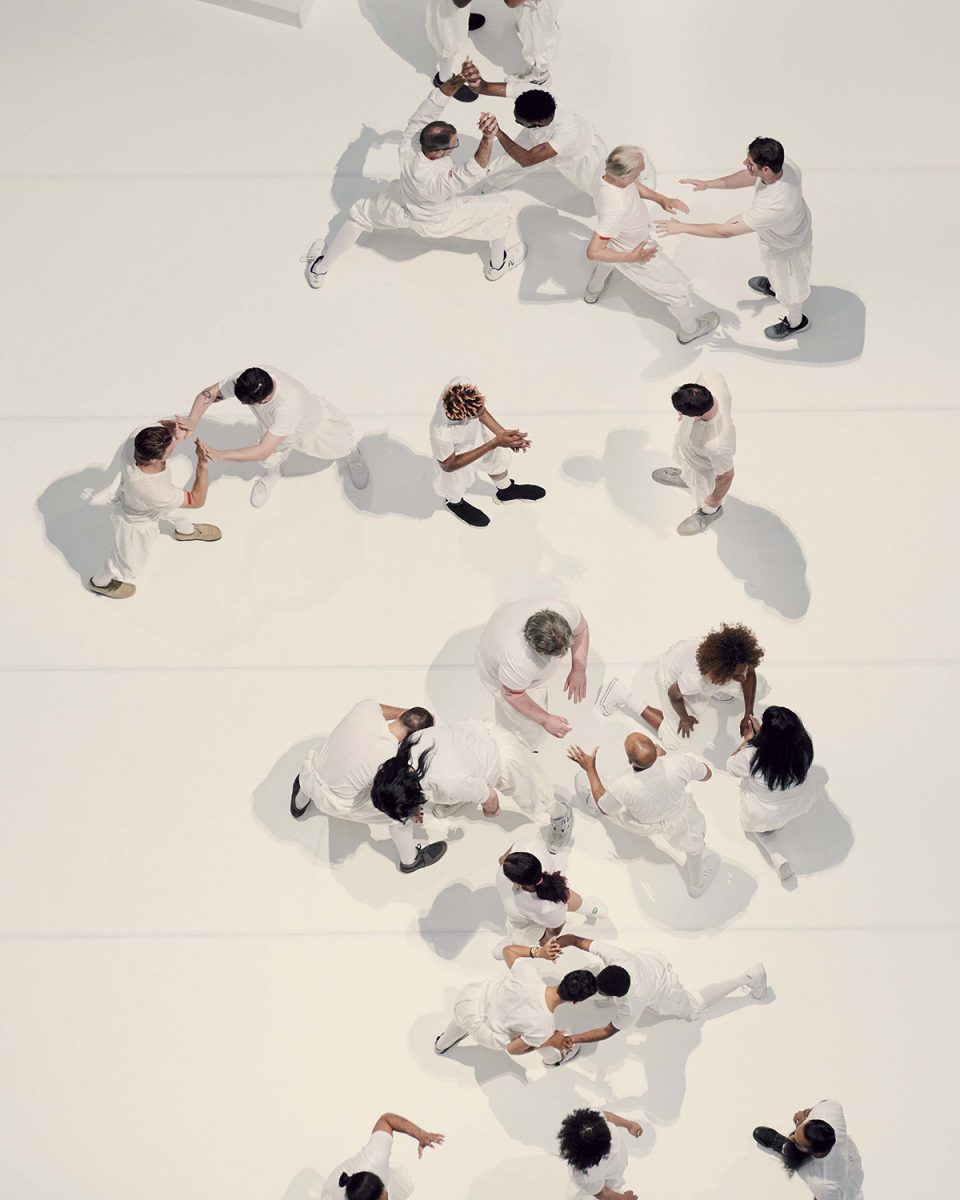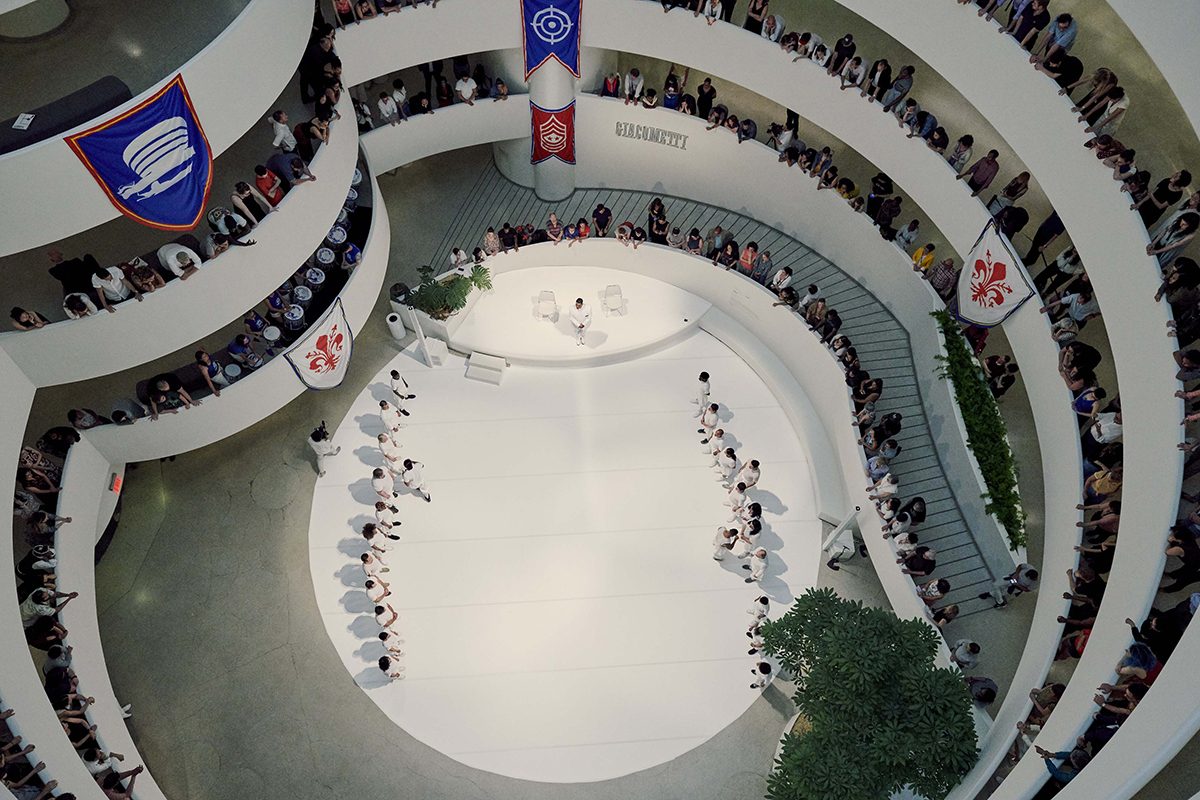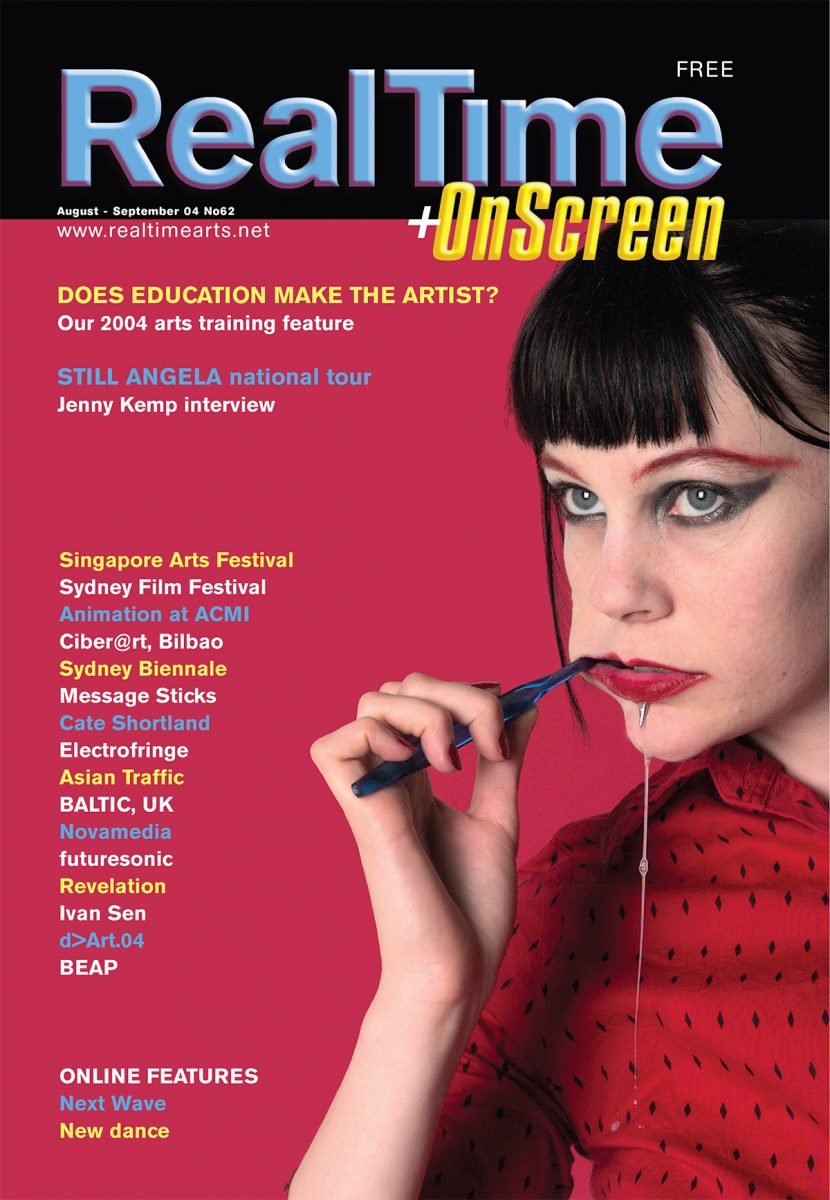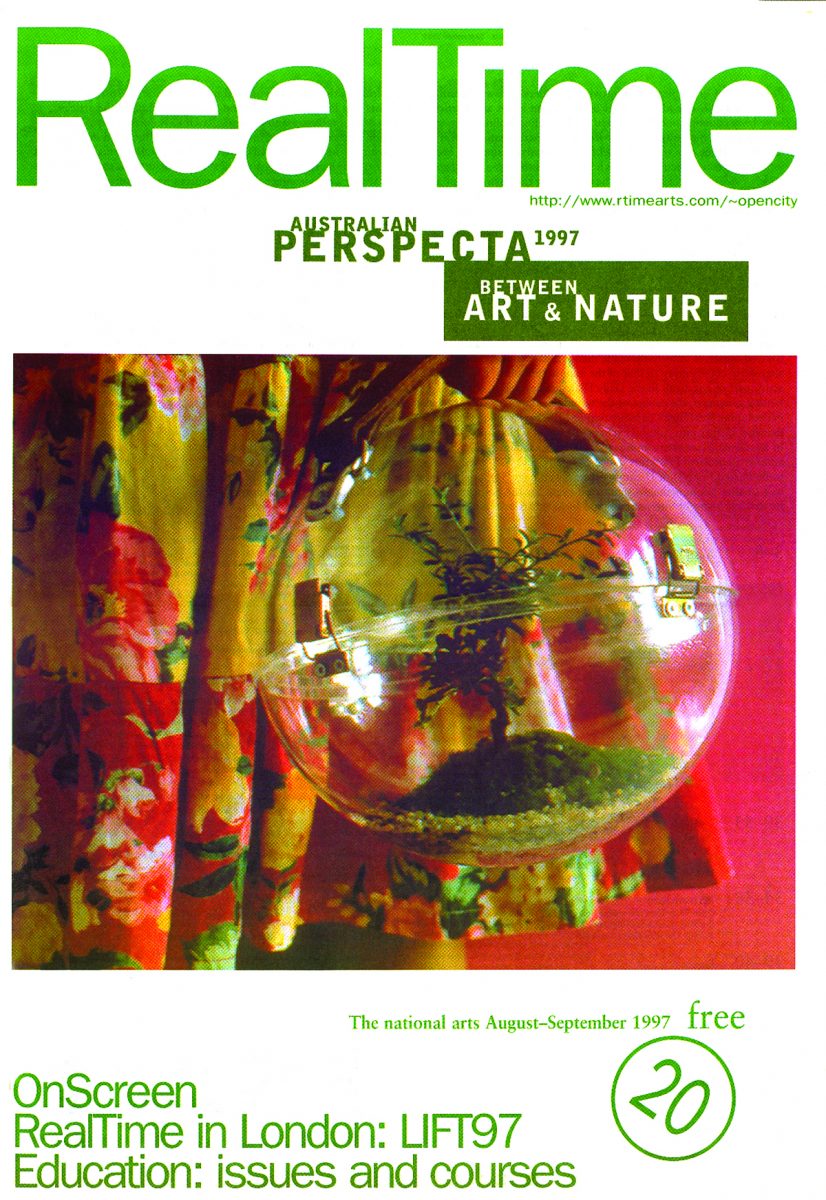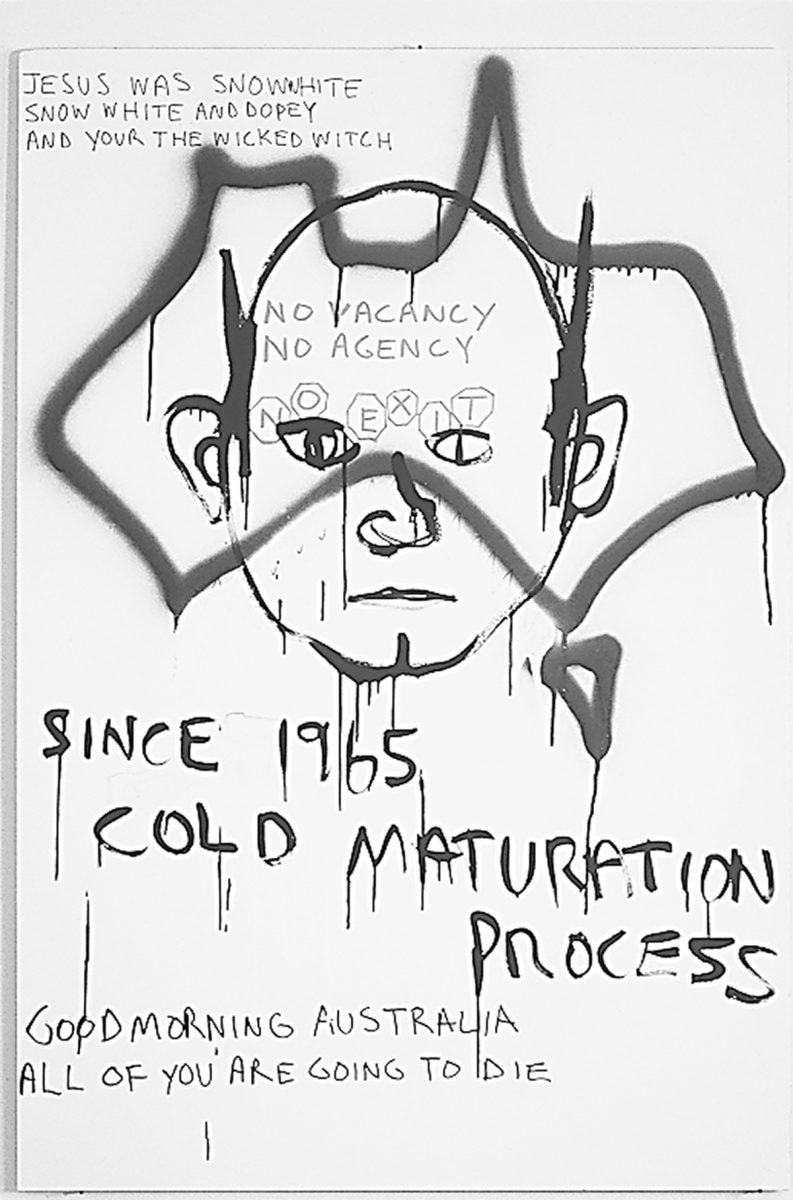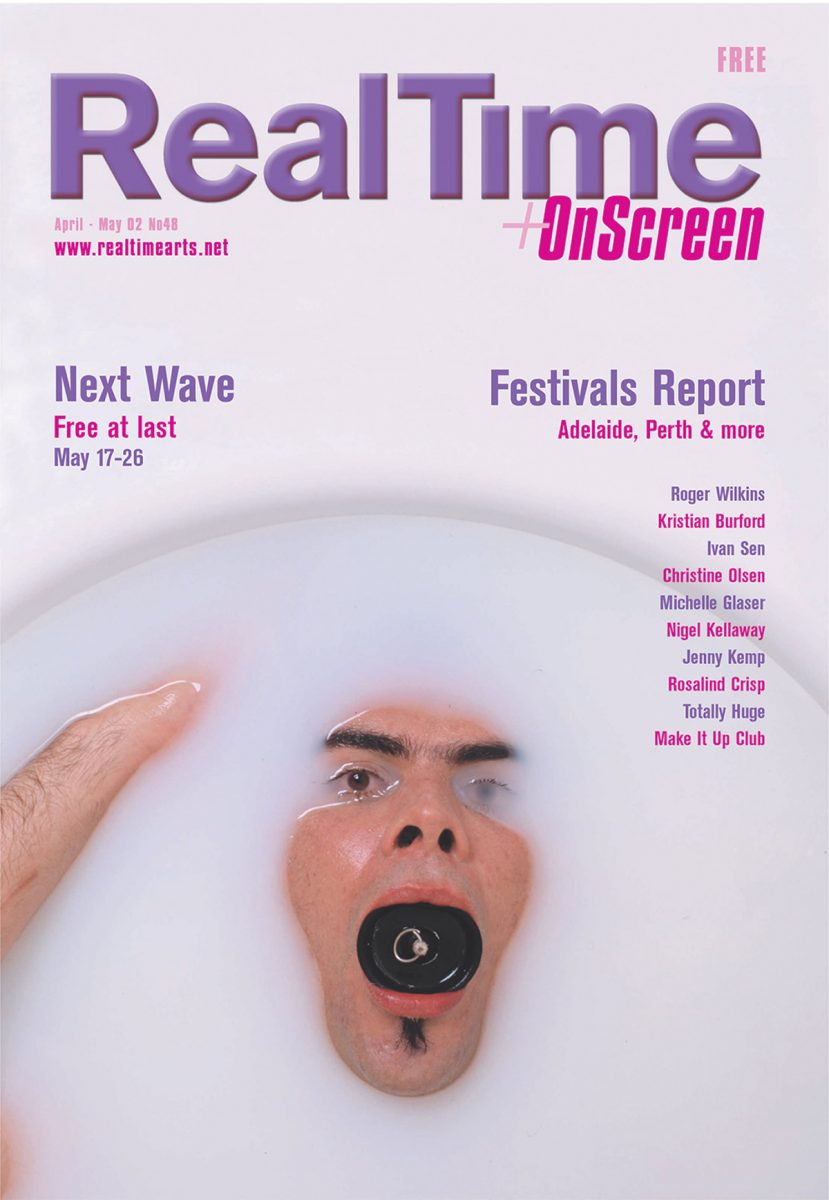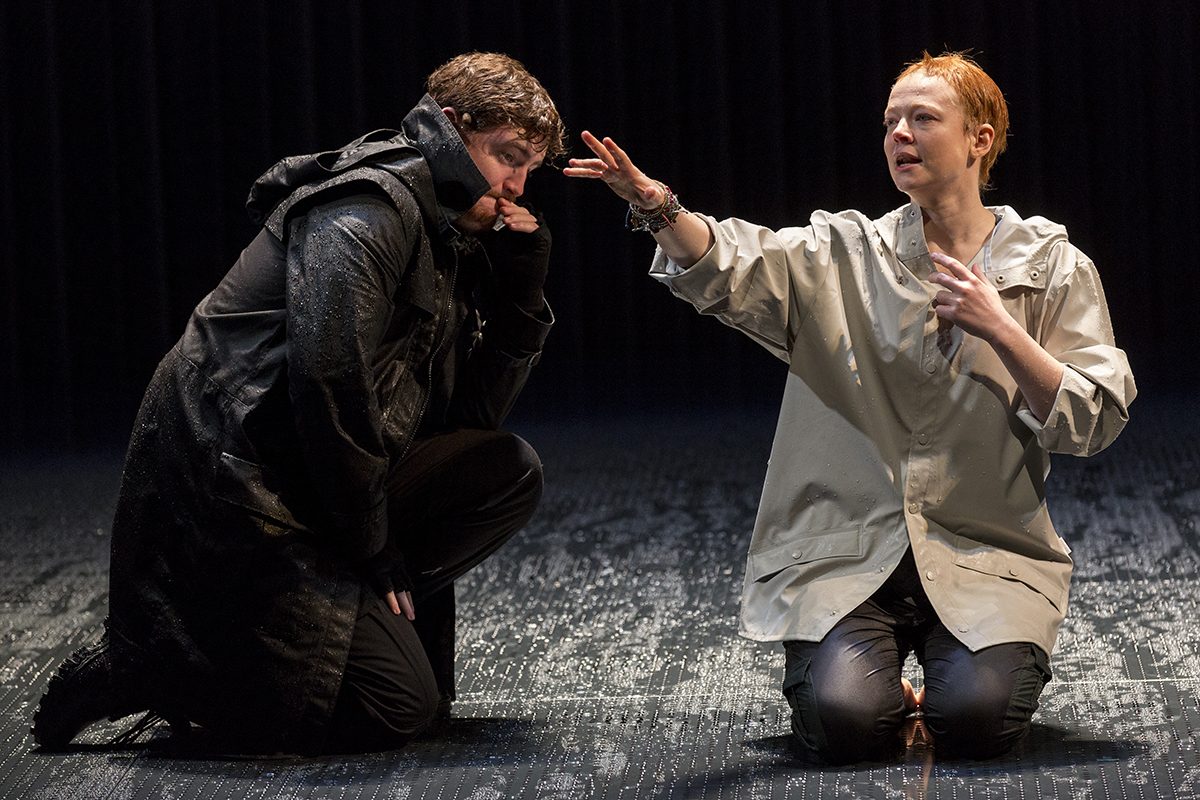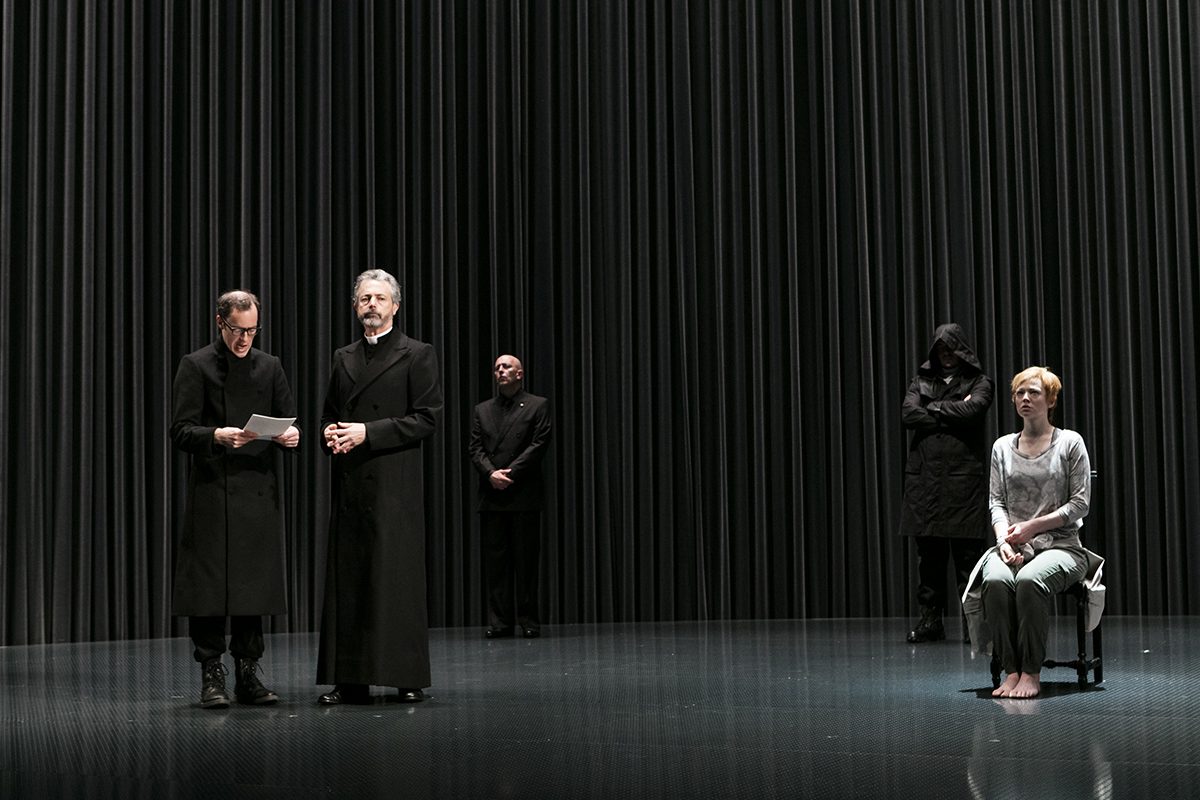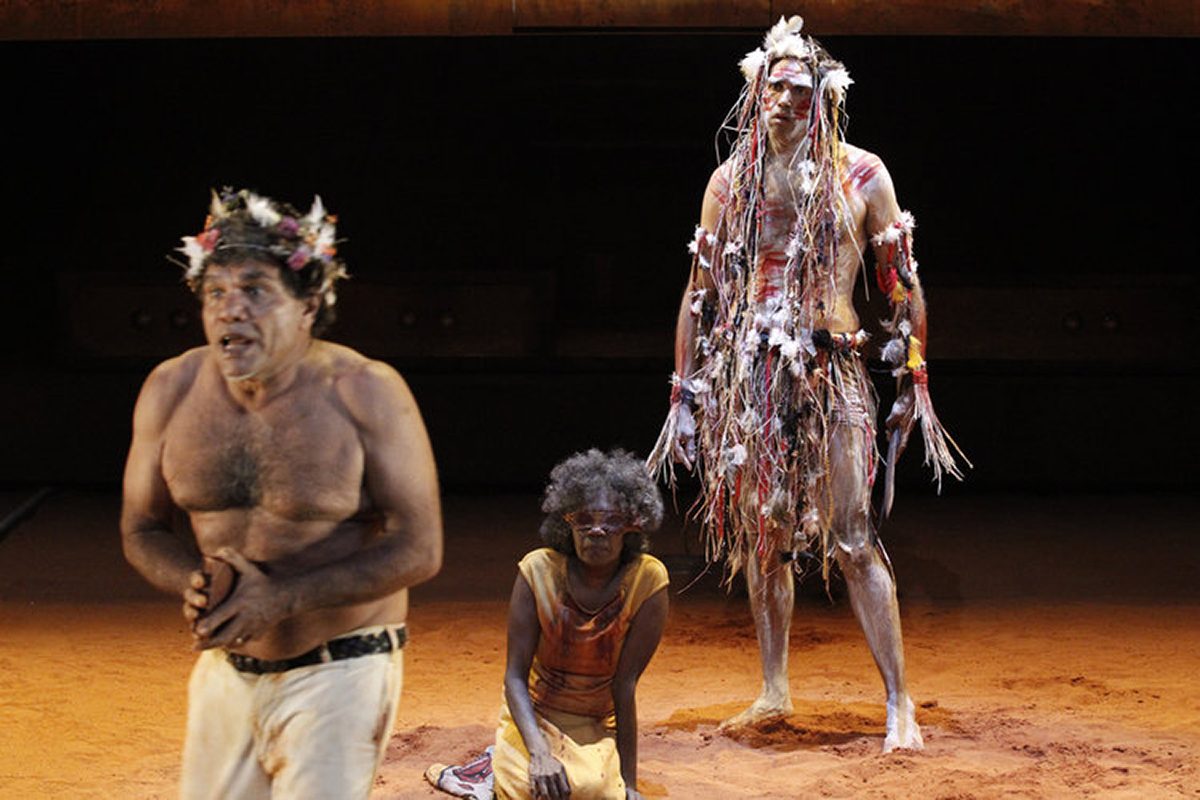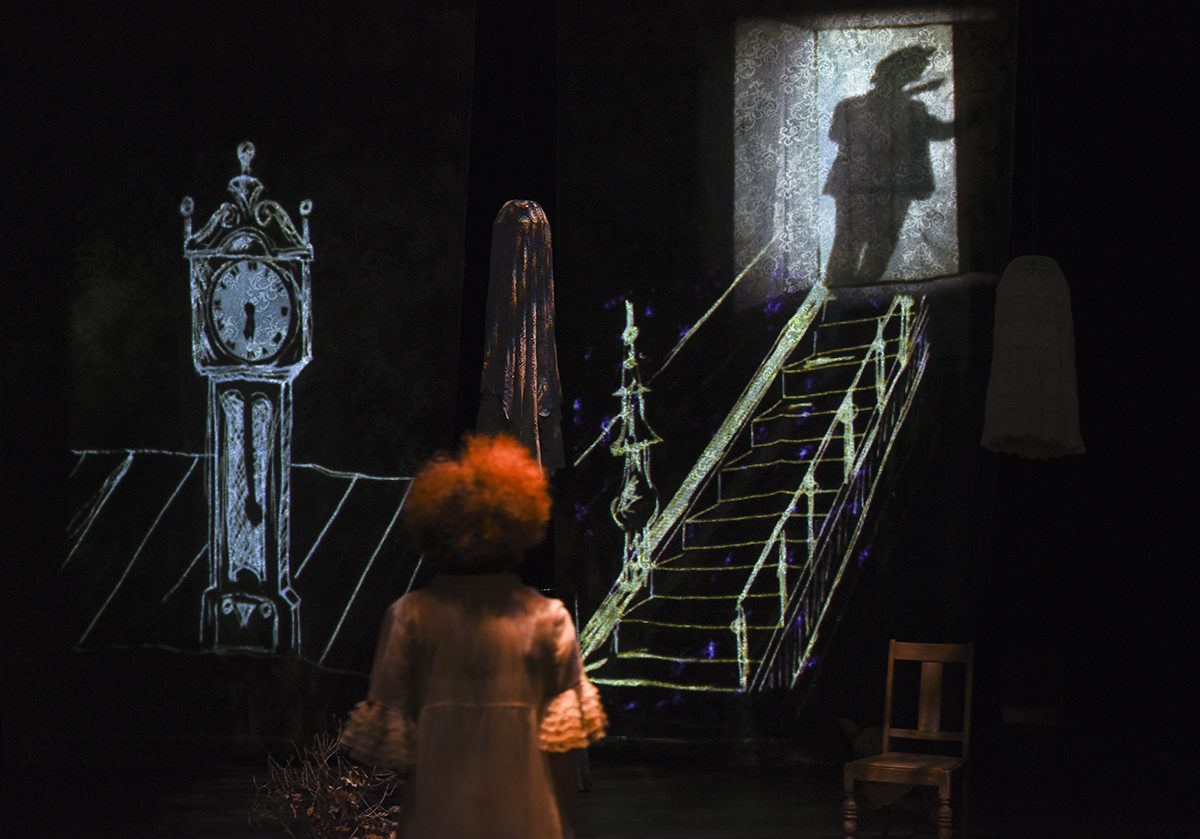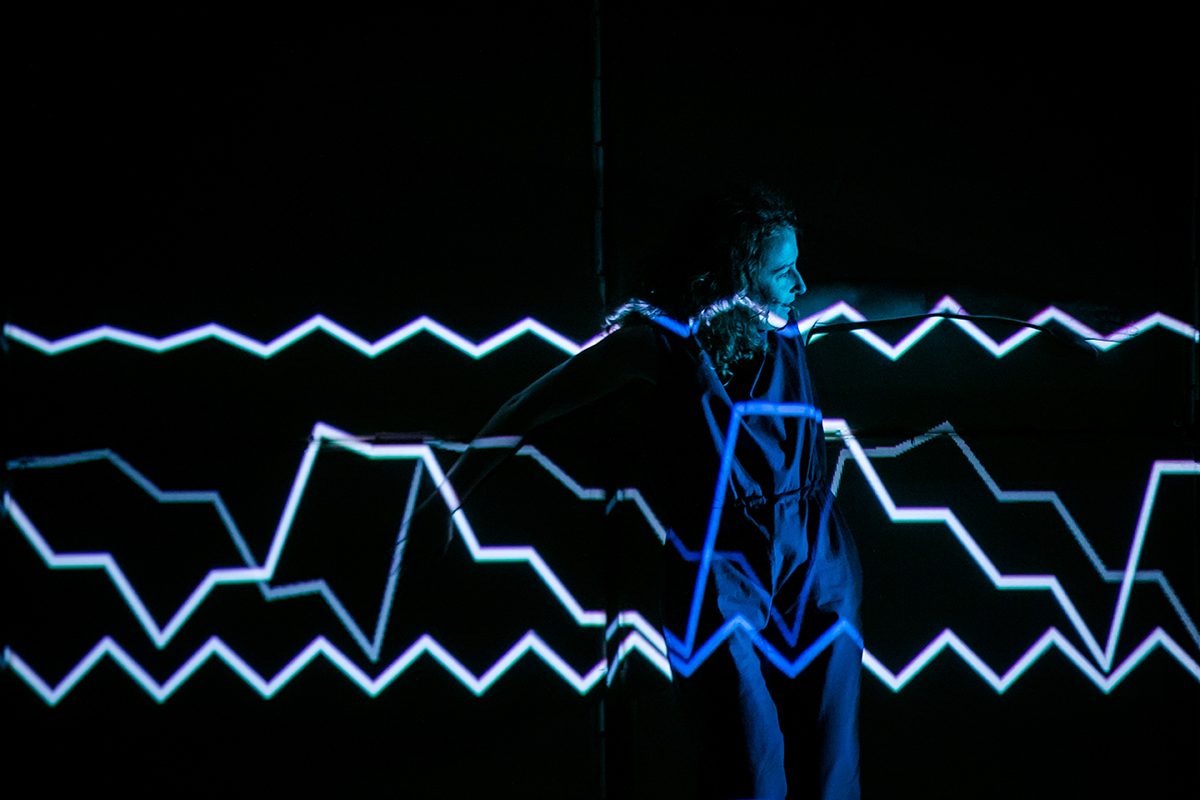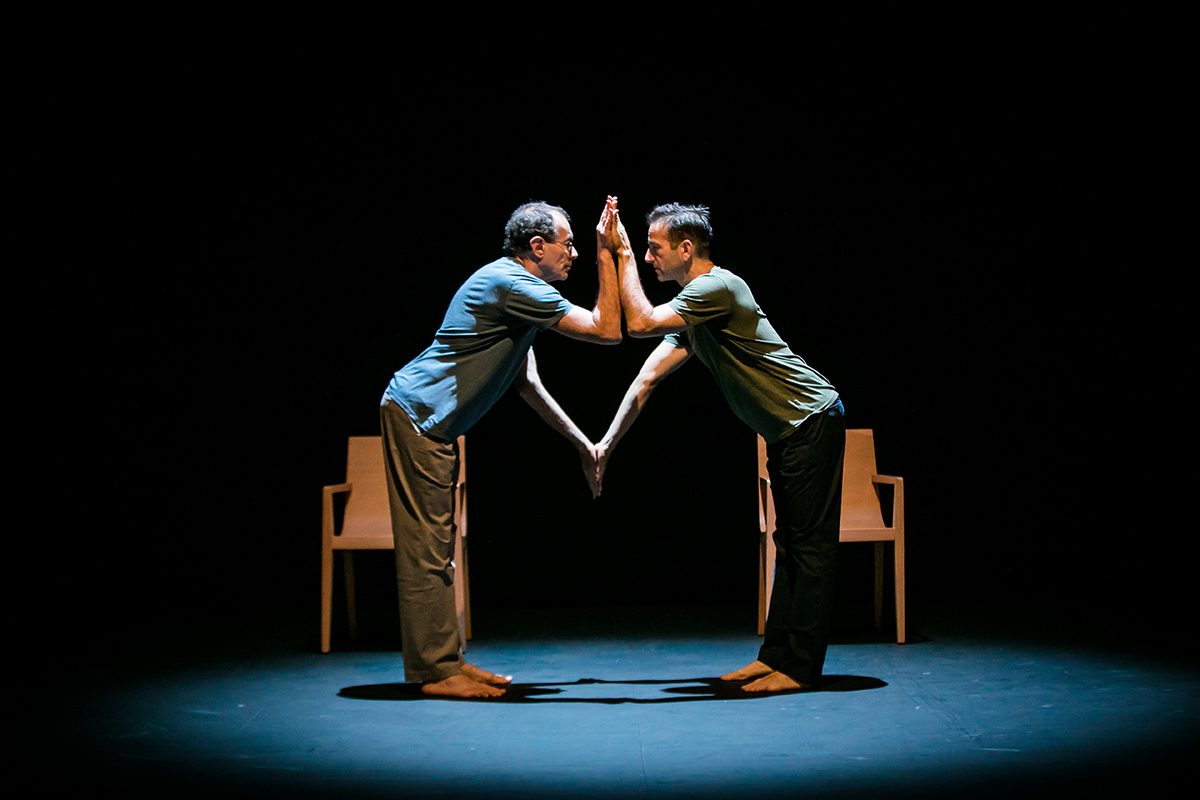June 2018
Hot off the press!! At long last RealTime print editions 1-40 are available in our online archive. PDFs of each edition preserve the look of RealTime and each is searchable — treasure chests of highly responsive reviewing, critical thinking and, yes, humour (we even had ‘sports’ columns in those days).
With today’s edition we proudly commence our series of Archive Overviews by RealTime writers. Virginia, addressing RealTime responses to Australian Indigenous performance 1994-2000, and Katerina, surveying our visual arts coverage 1994-2004, have invested many weeks delving into the magazine’s inky pages to produce comprehensive accounts detailing key emerging artists and forms and political, cultural and funding challenges. These provide excellent pathways into our archive.
Our archiving is in transition. We currently have two websites, 2001-2015 and 2016-present. The former is about to be incorporated into the latter, providing one access point. Until that happens, our Archive page includes all 1994-2000 and 2016-present editions while 2001-2015 editions can be accessed by going to RealTime’s original website.
Dive into the 1994-2000 archive and let us know what you think. Keith, Virginia, Katerina
–
Top image credit: RealTime Promotional image, 2002, photo Heidrun Löhr
In 1994, the year we launched RealTime, I was Chair of Playworks, the national development organisation for theatre and performance works by female writers. That year Playworks’ Director Clare Grant and I attended the Third International Women Playwrights Conference in Adelaide. A range of works were showcased with a focus on the relationship between traditional ritual or storytelling and contemporary theatre created by women. One performance that left a strong impression was by a group of women from Ngaanyatjarra, Pitjantjatjara, Yankunytjatjara Women’s Council in Central Australia.
The first part of the performance was for women only and required us to keep secret. What followed featured song, dance and what appeared to be impromptu commentary from a chorus stage left. There were soft ripples of laughter as the women encouraged one another to take centrestage. As some performed simple movements, others sang in unison and then casually returned to the sidelines, promptly dropping all sense of occasion and then repeating the pattern.
As casual as this performance appeared, I subsequently learned that it had a serious function, as “an expression of Jukurrpa, a term that can apply to individual ancestral beings, or to any manifestation of their power and nature, ie knowledge of their travels and activities, rituals, designs, songs, places, ceremonies. The Jukurrpa provides the ‘Law’ for all human and non-human activity and, because it is not fixed in any temporal sense, it is conceived as a continual living presence” (Women’s Intercultural Performance, Julie Holledge and Joanne Tompkins, Routledge, 2000).
At the time, I sensed in this performance with its easy synthesis of elements a certain resonance with much contemporary performance I’d been involved in making and observing throughout the 1980s and early 90s with its emphasis on the fluid combination of artforms (image and sound, movement and speech). This link, of course, has been explored by Performance Studies theorists since at least the 70s but I think this was the first time I’d actually felt the connection. I also sensed an affinity with its framing of time. The imaginary time inhabited by actors spinning narratives in conventional theatre had been replaced in much contemporary work by performers embodying or enacting states of being in real time.
So central was this latter idea to our thinking that we chose “RealTime” as the title for the publication in which we intended to expose to a wider audience the breadth of what came to be called ‘cross-art form’ and later ‘hybrid’ and thence ‘multi- or interdisciplinary’ practices and to dialogue with artists and their audiences through writing that conveyed a strong sense of the experience of the work. This brought us into contact with the innovative ways many Indigenous artists were dealing with ideas of tradition and contemporaneity in the creation of new works and how they reflected the changing politics of black and white Australia. We observed Indigenous artists drawing on and sustaining traditional cultures, integrating them with Western art forms in which many had been trained or finding ways to work when they were distanced or displaced from those cultures.
Indigenous writers published in RealTime in this era included Catriona McKenzie, Walter Saunders, Lester Bostock, Archie Weller on film, Terri Janke on multimedia rights, Djon Mundine on visual arts. Indigenous writers on theatre and performance were not prominent save for Wesley Enoch, then Artistic Director in Brisbane of Indigenous theatre company Kooemba Jdarra and who would become in this period an important contributor to RealTime, bringing his sharp intelligence to the discussion around definitions of form and indigeneity.
The Cherry Pickers
About his 1994 production of Kevin Gilbert’s classic play The Cherry Pickers (1971), Wesley wrote: “The further appropriation of [Western] performance form joined with Kevin Gilbert’s appropriation of English and conventional playwriting format basically facilitates the storytelling and in no way undermines its credibility as an Indigenous story. The script is used as a vehicle to publically discuss issues of traditional cultural appropriation, health and mortality, alcohol dependence and economic disempowerment” [RT4, p 15].
The Aboriginal Protestors…
Another bold experiment which, inexplicably, was only briefly previewed in our account of The Performance Space’s 1994 program was Mudrooroo’s The Aboriginal Protesters Confront the Proclamation of the Australian Republic with a production of The Commission by Heiner Muller, directed by Noel Tovey. A play within a play, it was heralded elsewhere as “one of the great landmarks of black theatre in Australia and performed to capacity houses throughout the Sydney Festival…an extraordinary confluence of texts of Aboriginal political activism and the grand master of avant-garde theatre, Heiner Müller. The Aboriginal Protesters… is set in Canberra on the eve of the declaration of the Australian Republic [AusStage].
Bindjareb Pinjarra
Back then, and still, reconciliation was high on the agenda and a strong focus in much Indigenous work, even when the subject matter was genocide as in Bindjareb Pinjarra produced in Perth in 1995. Sarah Miller, our Perth correspondent at the time, wrote, “From the outset the performer/devisors of this work (Geoff Kelso, Trevor Parfitt, Kelton Pell, Phil Thomson with set paintings and graphics by Ron Gidgup) committed themselves to creating a work which gave Nyoongah (SW Aboriginal Australians) and Wedjella (European Australians) equal power and ownership over the product…[while] enacting racism’s fundamental absurdity” [RT8, p 4].
The Seven Stages of Grieving
In 1996 Wesley Enoch with co-writer and performer Deborah Mailman conceived, in collaboration with visual artist Leah King-Smith, their ground-breaking work The Seven Stages of Grieving, comprising text, image and movement integrated as in traditional Aboriginal performance and, importantly, as the creators described it, specifically devised with Aboriginal audiences in mind. Elaborating the grief of dispossession, Seven Stages also spoke to a wider audience though surprisingly, its radical model was largely not to be repeated. Josephine Wilson previewing the work in 1995 noted: “The Mabo decision and the agenda of reconciliation place the question of historical truth at the centre of Australian national identity. Seek[ing] to assert for Aboriginal people that it is not yet time to forgive and forget, the performance sets out to enact what has historically been denied Aboriginal and TS-Islanders: the right to public mourning and personal grief. This denial was explicitly under the doctrine of terra nullius…how can you mourn that which never was?” [RT#8, p5].
In 1997, the work toured to the UK as part of the London International Festival of Theatre (LIFT). RealTime was also a guest of the festival, assembling a team of Australian (including Wesley Enoch) and British writers to cover much of the program. One of our British writers, performer Zahid Dar, described The Seven Stages… as “a hybrid of Indigenous oral and physical storytelling traditions mixed with the multi-layered textuality of current Western theatre practice. There are many stories entwined in its collage of visual, vocal and movement imagery. Deborah Mailman’s performance becomes a collective grieving: it explains the grieving stages of Australian Aborigines and at the same time, allows the audience to personally experience that process of pain, loss and sorrow, not as some kind of denial of history and oppression or even suppression, but as catharsis. It allows us to engage with history and the experience of a people and to believe that there is a recuperative dimension which enables reconciliation” [RT20, pp 45-46].
MIMI
Another significant work, this time involving Indigenous and non-indigenous artists and with a traditional creation story at its centre, first appeared in RealTime in 1996 [RT12, p 15] MIMI, a collaboration between two Sydney-based companies Stalker and Marrugeku featured five stilt dancers, three Kunwinjku musicians from Arnhem Land and was narrated by traditional storyman Thompson Yulidjirri. Performed under the stars at the 1996 Perth Festival, MIMI caught the imagination of many, touring extensively to Australia’s cities and Aboriginal communities to become one of our most successful cultural exports on the international festival circuit, as was the 2001 work Crying Baby (see image). Currently based in Broome and led by Artistic Co-Directors Dalisa Pigram and Rachael Swain, Marrugeku has expanded its intensely collaborative team to include composers and filmmakers and, reflecting the growing international interest in Australian Indigenous performance, European performance theoreticians and artists.
Festival of the Dreaming, 1997
MIMI also featured at the hugely influential Festival of the Dreaming in 1997 prominently covered in our pages. Curated by Rhoda Roberts this was the first of three major festivals in the lead-up to the 2000 Olympic Games in Sydney. Roberts’ program celebrated the considerable achievements of Indigenous artists in a wide range of theatre, performance, dance, film and the visual arts.
These were politically dark times. In the opening address of the Reconciliation Convention, John Howard deemed centuries of dispossession and violence insignificant. In protest Indigenous delegates in the audience turned their backs on the Prime Minister.
Box the Pony
Within the Festival of the Dreaming, the Wimmin’s Business program showcased a number of solo works that expanded on the autobiographical storytelling form. Reviewing Leah Purcell’s Box the Pony (co-written with Scott Rankin), I was taken with the way the performer “move(d) rapidly through personifications of character and self without the constraints of tight theatrical framing…from rural roughhouse to city savvy. ‘Bullshitting is basically what I’ll be doing here tonight,’ she confessed” [RT21, p 4]. Purcell’s style mixed pride and self-deprecation, at turns baiting, cajoling and charming her audience. Box the Pony marked the beginning of a stellar career for Leah Purcell.
Ningali
On the same program, Ningali Lawford excited us with her mix of English, Aboriginal English and Walmajari in her eponymous show, co-devised with Angela Chaplin and Robyn Archer and premiered in 1995 by Deckchair Theatre in WA. “These are not my stories, they are mine through my eyes, what I saw through my eyes but they are the stories of all the people that have lived the way I’ve lived: stations. People that got taken away, everything. They are stories for those people and worth being told. Aboriginal people have always been visual people, physical and oral people and that’s the way I wanted to present my story. Straight. Straight from the heart” [RT21, p4].
This form of direct-address performance including Deborah Cheetham’s White Baptist Abba Fan was soon taken up by other Indigenous artists sharing personal stories. These included Tammy Anderson (I Don’t Wanna Play House), Noel Tovey (Little Black Bastard), David Page (Page 8), Tom E Lewis (Thumbul), Jack Charles (Jack Charles vs The Crown, with John Romeril) and most recently, Jacob Boehme (Blood on the Dance Floor).
Critical dialogue: off with the kid gloves
“I think there’s a level at which a lot of Kooemba Jdarra’s work escapes the level of criticism that it really needs to survive. The biggest problems are those of being smothered with kindness. Some people put on their kid gloves to talk to us and any kind of discussion comes from a place of white guilt. I think the challenge is to say, ‘What questions does the work raise?’ and allow people to answer them. Often I find that opinions that are given come from assumptions we don’t share” Wesley Enoch, [RT18, p 27].
Non-indigenous RealTime writers responding to work by Indigenous artists have always done so with a heightened sense of responsibility but this has never prevented our publishing constructive criticism or the expression of misgivings about a performance. In a 1997 article headed “The history of our dancing bodies is becoming hot,” Eleanor Brickhill had reservations about Bangarra’s production, Fish: “On stage the negotiations seem formal, distant. But the traditional material, both dance and music, is totally compelling and the effect is quite unlike watching the predictable paces of the western trained dancers in the group. Fish features Djakapurra Munyarryun, a performer whose physical language gives purpose and weight to the work. His gestures are mercurial and his meanings seem rich and clear, sharpened perhaps by unfamiliarity, hiding no clichés” [RT22, p 33].
In a robust exchange in 1997, EC Brown questioned Wesley Enoch about the director’s production of Radiance in which he sensed “the cultural autobiography [of playwright Louis Nowra] writ so large upon the story that it rendered the core of the play impenetrable.” He put it to Enoch that the anthropological reality had been overshadowed by the author’s own cultural baggage. This prompted Wesley to argue, “I think the first point is to interrogate the assumptions with your reading of the piece, in terms of what is the Aboriginal experience. The argument comes down to authenticity and who holds the forms of representation and in this case we’ve allowed Louis Nowra to create these characters for us to play. One of my big arguments is that as Murri people we must control our forms of representation. But what makes an Aboriginal work? Is it the writer? The director? The actors? Is it something like Bran Nue Dae or Corrugation Road which are actually written by Aboriginal writer Jimmy Chi but directed and designed by non-Aboriginal artists? When is it a creative position and when is it an interpretive one?” [RT18, p 27].
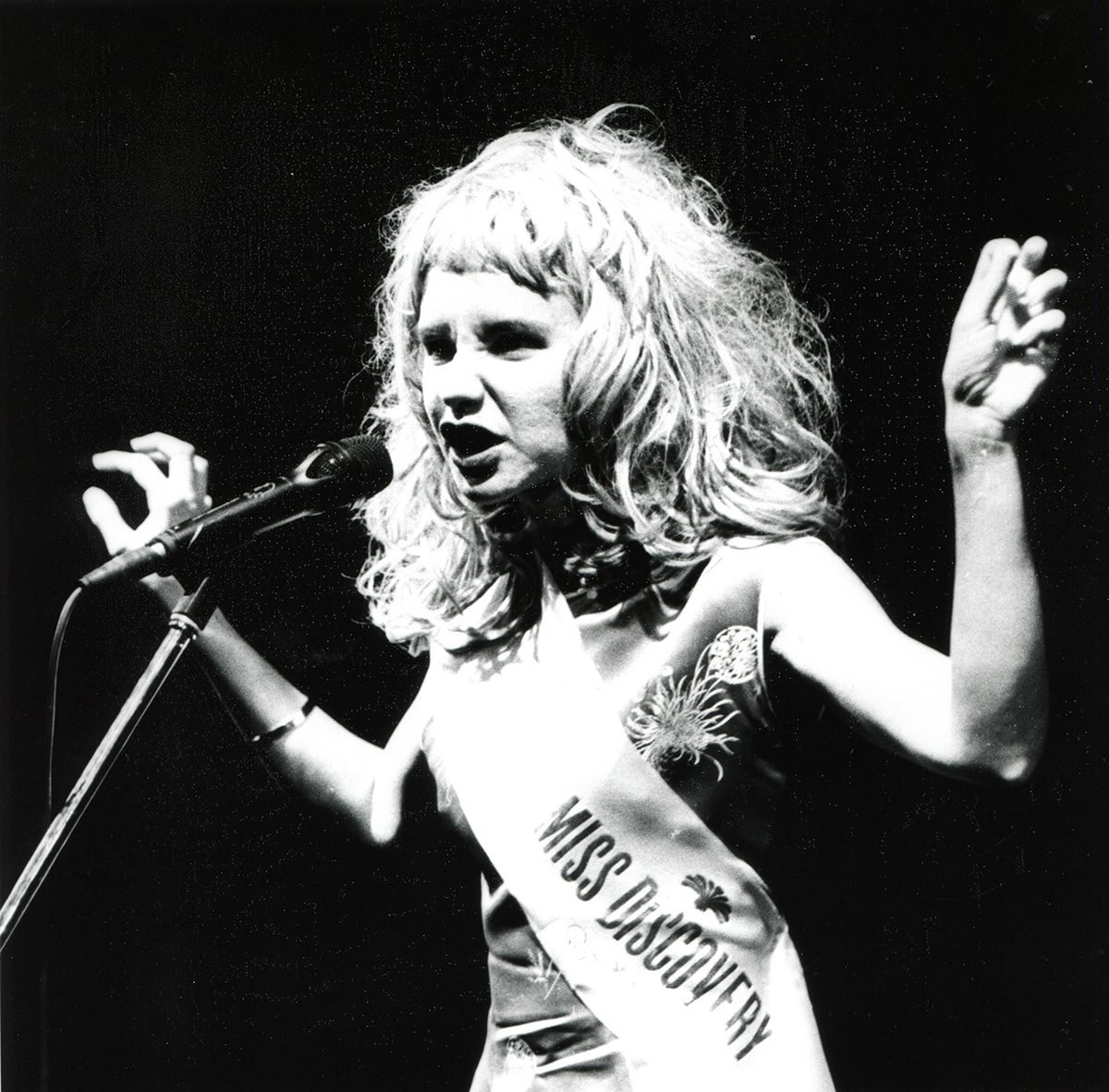
Erin Hefferon, The Geography of Haunted Places, photo Stephen Smith courtesy Perth Institute of Contemporary Arts
A non-Indigenous voice: The Geography of Haunted Places
Works by non-indigenous artists also contributed to the debates concerning Australia’s reconciliation with its past. The 1997 national tour produced by PICA in Perth of Josephine Wilson’s The Geography of Haunted Places, a solo performance by Erin Hefferon about colonisation, domination and memory, coincided with the launch of Pauline Hanson into the world of federal politics. Writer Barbara Bolt commented, “Written in 1994, Wilson had imagined she was laying ghosts to rest, that in talking about the brutality of the events we could take stock of our past, in preparation for a ‘better’ future. But the hope for a talking cure has receded rapidly and The Geography of Haunted Places has become prophetic.” [RT19, p 3].
In 1997, the work was performed at the London International Festival of Theatre (LIFT) and among the surprising UK responses was one from The Independent’s Adrian Turpin who confessed that he “couldn’t give a monkey’s” for the work’s “attempts to tell a few home truths about colonialism and white bread Ozzie culture,” to which I responded, “…in restaging this work, LIFT 97 has given Britons a chance to share images of Australia that they might easily disown at this distance. Here for a brief visit is your wayward daughter, ours too, wanting you to see just what the racist impulses of our white forbears have fathered” [RT20, p 44].
Looking for respect, sharing pride
In 1998, a year in which the rapid rise of Indigenous filmmaking also vied for our attention, we consistently covered Indigenous issues. Jo Holder reported on creative responses to the government’s overturning of the High Court’s Wik decision, including the formation of Australian Artists Against Racism or AAAR! “pronounced as a pop-art roar” [RT25, p 3]. An article from leading visual arts curator and regular RealTime correspondent Djon Mundine vividly elaborated on the history of the struggle for land rights and identity in relation to Indigenous art, finally calling on all Australians to take pride in our Indigenous heritage: “We need to see the real contribution Indigenous people are making through their art, not only economically (which is considerable) but spiritually. The struggle of the Yirrkala people for land rights and the survival of Tiwi identity through their cultural expression enrich the lives of all of us” [RT25, p 3]. This idea is yet to be wholeheartedly embraced by white Australia.
In the same issue Georgina Clarsen reported on the Fullbright Symposium with its theme of Tolerance and Cultural Diversity, Pluralism and Human Rights: “Adelaide was a particularly poignant location, given that the High Court had ruled only days before against the Ngarridjeri challenge to the Federal Government’s Hindmarsh Island Bridge Act. To add to that the shameful scenes in Canberra as the Government’s 10 Point Wik Plan was debated and the haste with which it was conducted to fit in with the Easter break, left many of us feeling that the chance for reconciliation was slipping away perhaps for another generation. The mood was heightened by Cherie Watkins when she did more than welcome us to Kaurna country, but asked how reconciliation was possible without fundamental respect for Aboriginal knowledge and law. Ronald Wilson reminded us, we don’t have to wait for governments, we must do it as a people’s movement…Reconciliation, after all, is not an end (since what is considered reconciliation may change) but a continuing process which needs constant re-assessment and affirmation” [RT25, p 8].
Reconciliation action
In this period, a tremendous amount of the work of Reconciliation was taken on by artists. EC Brown spoke with Lafe Charlton, the new AD at Kooemba Jdarra about his 1998 program which was heavy on training, workshops and regional development. Charlton reported: “An ongoing component of the company’s work, the workshop and training program operates as an outreach facility to schools and community groups to promote cultural awareness through the arts. The aim of this self-funded component of the program is to promote that most nebulous of terms, reconciliation” [RT25, page 6].
In 1998 Melbourne company Not Yet It’s Difficult in collaboration with Theatreworks and academics from the Koori Research Centre at Monash University organised a Reconciliation & Theatre Forum, stressing the importance of consultation to avoid misrepresentation so commonly experienced by both whole communities and individuals [RT26 p16]. In 2002, the Australia Council was prompted to publish a detailed set of protocols for working with Indigenous artists.
Youth theatre companies across the country devised all manner of programs to encourage emerging Indigenous artists. Responding to an Australia Council program funding Aboriginal skills development, Port Youth in South Australia instigated a rigorous process of consultation in their work with young Nunga people. Director Ollie Black, interviewed by Anne Thompson, stressed “Employing Aboriginal workers (important it’s more than the token one) they found they needed to be open to the social networking which is a crucial part of life in a community. ‘What we might call ‘gossip’ works as a survival strategy. This networking and their kinship system are the traditional things that are extraordinarily strong, even in an urban Aboriginal community. Auntie Josie works here three afternoons a week, but a vital part of her job is going for a walk in the mall at lunchtime so she can hear what’s happening’” [RT27, p 32].
Stolen lives: King Hit, Stolen, A Life of Grace & Piety
In 1997 Perth’s Yirra Yaakin production of King Hit marked the maturation of the company after their first ‘professional’ production that same year when they ceased to be a strictly youth theatre company. Of King Hit (by David Milroy and Geoffrey Narkle) based on the life of Aboriginal tent boxer Geoffrey Narkle, a member of the Stolen Generations, Sarah Miller wrote, “Its extraordinary achievement was to build the narrative so transparently from beginning to middle to end so that there could be no mistaking the locus of the pain, but more importantly the anger, the rage and the seemingly incomprehensible self-destructiveness. No Pauline, No John, there are no neat clean white middle-class answers to this one but an apology might be a start down a different road” [RT22, p 16]. This would not come until 2008.
1998 marked the premiere production of Jane Harrison’s powerful play Stolen staged at Malthouse and directed by Wesley Enoch. Based on the lives of five Indigenous people dealing with issues stemming from forceful removal as children by the Australian government, the play has since toured extensively within Australia and internationally and is studied widely in schools. In 2016 we reviewed the National Theatre of Parramatta’s production of the play directed by the ever inventive Vicki Van Hout who expanded on the narrative by texturing the production with a meld of naturalism and the mythic. As in all of Van Hout’s work, design was an important element. She described designer Imogen Ross’s cardboard objects being used, “like we would dancing feathers which when finished with are tucked back into the folds of our skirts, to be replaced by leaves or small branches acting as spears or the beaks of cranes, perhaps the motion of the west wind or of the fog rolling off the mountains” [RT 133].
Lafe Charlton’s 1998 program opened with A Life of Grace & Piety by writer-director Wesley Enoch, a collaboration between Kooemba Jdarra and Cairns-based JUTE. Our writer Julie Goodall described the experience as “transcendental” and went on to say “Enoch touches on issues surrounding the Stolen Generations without attempting to play on our guilt or pity. It is as if life is too important for such negativity…The different kinds of writing in the play provoked strong opinions among the theatregoers on opening night at the Cairns Civic Theatre: its wordless scenes, its sparkling naturalism, its poetic monologues gave it a rich texture and for me it was a thrilling use of the theatrical medium, of space and movement and image. I particularly enjoyed John Kelly’s sound design which gave the production great subtlety and richness” [RT26, p 38].
United voices
Experimentation with form by Indigenous performance-makers continued throughout the 1990s as did the critical dialogue with RealTime. The 1998 New Narratives program at Performance Space included performance poet Romaine Moreton’s United Voices of which Keith Gallasch wrote: “It’s a simple website where you get complete poems performed with a percussion track. In My Genocide you can call up a word or phrase from one of Moreton’s poems and get information on, say, media responses to an event like the killings at Port Arthur and their implicit erasure of black history. It exploits existing formats on the net such as the 60-second rock clip and uses hypertext for good political ends. It will be interesting to see where it goes from here. What’s clear is that the technology of the net is not yet able to convey the power of the live performer. Romaine Moreton performed three of her poems at the launch with percussionist Jan Goldfedder. She’s a dynamic performer who needs technology to match” (RT25, p 13). She achieved this synthesis in 2016 with her show One Billion Beats at Campbelltown Arts Centre.
Cruel Wild Woman
“History threatens to repeat itself in Yirra Yaakin’s Cruel Wild Woman,” wrote Josephine Wilson in 1999. Ethel (Lynette Narkle) is worried about Wik, she’s worried about the 10-point plan and she’s worried about her husband Charlie (Kelton Pell) who can’t let go of the form guide, and whom she suspects of pawning the vacuum cleaner at Cash and Carry. And then there’s that Woman in Red, Pauline Hanson, who keeps popping up everywhere.” (Written by Sally Morgan and David Milroy) Cruel Wild Woman manages to parody both paranoid politics and complacent responses to contemporary Aboriginal-Australian relations in a situational comedy in which the ‘local situation’ counts for everything and in which politics is enmeshed in the domestic drama of everyday married life … In this lounge-room, history is the place of bad dreams, from which we wake, thankful” [RT30, pp 8-9].
King for This Place
Grisha Dolgopolov’s 1999 article “Beyond the Black and White,” hinted at some of the complexities of collaboration. Reviewing non-indigenous writer Neil Murray’s play King for This Place he comments on the strength of its well-rounded performances (Trevor Jamieson, Melodie Reynolds, Sher Williams-Hood, Phillip McInness, Kelton Pell, Stephen Baamba Albert). Of the play’s political ambitions, he cautions: “Murray wanted to show how Aboriginal people and their cultural heritage can enrich white Australians. Although there is nothing new in this message it is certainly worth repeating and exploring at length. His second claim that spiritual sensitivity and attachment to land are not exclusively the preserve of Aboriginal people, while refreshing, is somewhat at odds with his first and requires some elaboration” [RT31, p 32].
In his 1999 review of Kooemba Jdarra’s first musical production, Therese Collie’s Goin’ to the Island, a play that “peers deep into the troubled eyes of a young Murri hothead,” Brad Haseman was impressed with the versatility of the five performers “adroitly handling multiple roles and easily swapping naturalism for song and dance and then back again” but unconvinced by an ending that resisted resolution. “In the move to closure, the defiant struggle for survival and recognition dulls into a mere celebration of optimism…Hopes seem contrived, cosy but celebrating the end of the play rather than the ongoing complexities and ironies of victory and defeat. After five years of destructive, mean-spirited public policy and apology-less regret, this ending seems to belong to another age, one whose time is yet to come” [RT33, p 27].
Casting Doubts
Another regular commentator on Indigenous issues, Suzanne Spunner at the 1999 Indigenous Arts Festival, reports, “Issues of identity were a primary focus and [urban Aboriginal] artists tackled them in many different ways. Koori Aboriginality is fluid, multifaceted, negotiable and often problematic and this was reflected in the works presented.” Heralding an issue that would become critical in the noughties, Suzanne reported on a promising work by Maryanne Sam titled Casting Doubts in which five struggling Indigenous actors are caught between ‘no more lap lap and spear’ and not looking Aboriginal enough” [RT33, p 9].
Triple Alice
Among the collaborative ventures involving Indigenous and non-indigenous artists, the Triple Alice project was one of the more ambitious. Poet and teacher Martin Harrison participated in this unusual meeting of Body Weather methodology and Indigenous culture staged in the Central Desert, and wrote about it for RealTime [RT35, pp 8-9]. It involved a collaboration between Tess de Quincey, Desart, the peak body for Central Australian Aboriginal Arts and Crafts Centres, Sydney University’s Centre for Performance Studies and Sydney’s Performance Space. Spanning three years (1999-2000), it included a forum, three performance sites and laboratories staged over three weeks of each year accessible through an interactive website. Triple Alice 1 (1999) focused on contemporary arts practices of the Central Desert and brought together non-indigenous and Indigenous artists (among them Dorothy Napangardi and Polly Napangardi Watson) and local guest speakers to contextualise the site. In a three-week intensive Body Weather workshop participants made sensory and experiential mappings of space – in this case the landscape 100 kms north west of Alice Springs at Hamilton Downs in the MacDonnell Ranges.
The Sunshine Club
Excited at signs of a new Indigenous musical theatre, Keith Gallasch wrote of the 2000 production of The Sunshine Club, “Wesley Enoch and John Rodgers’ The Sunshine Club politicises the musical form with wit and subversive complexity, making marvellous demands on its singers and giving its musicians moments of the avant-garde abandon Rodgers is famous for…It’s another sign that the musical, so long denied to be a natural or indigenous Australian artform has proved itself in its Indigenous manifestation here and in a very different way in its precursors Jimmy Chi’s Bran Nue Dae (1990) and Corrugation Road (1996)…The Sunshine Club is political music theatre driven by a disturbing dialectic of hope and despair, of the fantasy that is the musical and the real that is the history it elaborates in such loving and telling detail” [RT35, p6].
When we were able to do it in RealTime, we paired reviews of a work. Eve Stafford in the same edition [RT 35, p26] saw The Sunshine Club as “tell[ing] a Murri story to a largely mainstream audience…the creative team proves that Murri stories can fit the genre like a glove. Through ironic laughter owing more to Murri sense of humour than Broadway, the audience digests the bitter pill, the unfolding injustices of barred entry, legislated discrimination in rights of access, passage, association and assembly.”
Ochre & Dust
At the end of this period, at the 2000 Adelaide Festival I saw Ochre & Dust, a moving performance by Nura Ward and Nellie Paterson directed by Aku Kadogo, and responded: “Within an installation by Fiona Foley, from a large central mound of red earth the women tell their stories. Alongside is a scatter of shiny white bone-like sculptures and behind, a set of five elliptical screens projecting Heidrun Löhr’s atmospheric projections of the desert (many in black and white subvert the postcard familiarity of locations like Uluru). The power of the story of enforced departure and fragmentation in the community of Maralinga holds in the spare telling in Pitjantjatjara language translated by Ruth Anangka. Two strong women speak quietly and seriously in turn (“I’ll let this lady speak now”) eyes downcast, tapping lightly on the earth with spindly sticks. They sing with sadness about a community disabled by one thieving act that saw families split, relocated in country for which they had no language” [RT36, p 23].
Six years of experiment, growth, despair & hope
So in a mere six years, a period of political heavy weather, amid signs of hope and despair, we saw the emergence of a courageous generation of Indigenous artists many of whom were to become key players throughout the succeeding decades. This was an era of boldness and experiment from Indigenous performance-makers working independently and in collaboration with non-indigenous artists, going solo or forming Indigenous companies, some of which survive to this day. Much of the impact of this work relied on powerful performances, strong integration of visual, musical and linguistic elements and fearlessness in making strong political statements. Above all, Indigenous artists displayed a deep generosity in sharing the experience of contemporary Aboriginal and Torres Strait Islander life in all its complexity.
–
Top image credit: Crying Baby, The Marrugeku Company, photo John Green
An email exchange with Hobart-based RealTime contributor Lucy Hawthorne incidentally revealed that she was in New York “doing a two-week performance art residency with an emphasis on social engagement” and that she’d “just seen Shaun Leonardo’s Primitive Games performed at the Guggenheim. It was pretty spectacular, transforming the Guggenheim’s massive atrium into an arena. This first iteration of the work focuses on gun violence, bringing together police officers, people affected by gun violence, recreational firearms users and veterans.”
The New York Times previewed Primitive Games revealing the work to be inspired by Calcio Storico (“historical football”), a violent community ‘sport’ — often a no holds barred physical fight — mixing soccer, rugby, wrestling and boxing. Held once a year in Florence, possibly from the 14th century on, when not occasionally banned, it was initially a game for aristocrats until becoming broadly communal with four teams representing the quarters of the city.
In an ArtNet interview titled “Can Calcio Storico, an Ultraviolent Ancient Italian Sport, Help Heal Our Political Divides? Artist Shaun Leonardo Thinks So” Leonardo, who works on a non-profit, sentence-reducing “art-diversion” program for young people prosecuted for misdemeanours, has developed a non-violent, wordless, movement-based, body language version of the game to be enacted as a “debate” by volunteer participants in the museum.
Primitive Games was commissioned by the Guggenheim’s Social Practice initiative and aims to defuse violent situations in various circumstances and escalated by the violent, un-nuanced use of language in current public and political discourse. In the ArtNet interview, Leonardo argues, “So if we can more carefully read how our bodies move during these times, during these experiences, these memories of conflict, how is it that we can use that skill to better read someone that we’re perceiving to be ‘other’?”
I’m intrigued by Leonardo’s phenomenological strategy at a time when protests against gun violence in the USA are increasing on the street and in the lobbying of politicians. I wonder what art, other than plays and television series, can bring to the issue, even on small and, optimistically, viral scale. Lucy’s response is not encouraging:
“The arena floor and participants’ clothes are the same white as the museum’s walls, and the result is visually slick but also somewhat sanitising. As with many such projects, the success of Primitive Games cannot be measured purely in terms of the end performance, but I do question whether performing the work for a relatively small art world audience at the Guggenheim can really effect cultural and political change. Addressing gun violence in the USA through socially engaged art while guns are so readily available seems akin to trying to fix a life-threatening wound with just a flimsy bandaid.”
Whatever its limits, the project is appealing as perhaps one of a number of potential strategies to engage creatively with violence in unexpected ways. I’m curious to see how it evolves.
–
Top image credit: Primitive Games, photo © Vincent Tullo/The New York Times/Headpress
This is Part 1 of a two-part look at RealTime’s visual arts coverage. Read Part 2 here.
As Assistant Editor this year for RealTime, I’ve had the enviable role of sifting through all 64 editions from the magazine’s first decade in order to survey visual arts coverage during this period. While RealTime is perhaps best known for its documentation of experimental performance and media arts, I found such an abundance of visual arts material that one of my biggest challenges was deciding which pieces to highlight in an overwhelmingly erudite and thought-provoking collection.
My own relationship to RealTime, and to visual arts, is a close one. I’ve proofread the magazine since 2010, started reviewing films for it shortly after and joined the in-house staff in 2012 as Advertising Sales Manager. As a reader, I first picked up a copy at a dance studio in the early 2000s. Before that, in the late 90s, I was a fine arts student at COFA (now UNSW Art and Design), a member of the generation of young artists that figures in RealTime’s often bleak coverage of the impact of economic rationalism on tertiary visual arts education and artist-run spaces in Australia at that time.
Being propelled through these articles back to the world of a younger self was disorienting yet illuminating; seeing the period encapsulated and analysed here gave a wider context to personal memories. Something that struck me particularly was how RealTime’s first decade coincided with a period of transformation in the arts: technically, with the rapid onset of digital technologies, politically, with economic rationalism, and culturally, with Indigenous and Asian-Australian artists gaining prominence.
In Part 1 of my two-part overview of the decade 1994-2004, I look at coverage of the structures and institutions that facilitated new developments in contemporary art — tertiary education, the alternative gallery scene, state-funded festivals of contemporary art, and, in a wide-ranging historical overview by Djon Mundine, the Aboriginal art “industry.” I then move on to discuss other surveys of Indigenous art.
Interconnectivity & emergence
RealTime’s Managing Co-Editor Keith Gallasch has described Sydney’s contemporary arts scene during the 1990s as a golden age of interconnectivity between art forms. From the magazine’s inception in 1994, RealTime reflected and promulgated this sense of hybridity in a national context, enticing readers to traverse artforms rather than sticking to their primary interest areas. Amid the vast array of practices reviewed, the visual arts were no exception, with works and exhibitions typically complex, multilayered and resistant to categorisation.
A selection of artist interviews is illustrative: UK-based Crow, whose grunge installations encompass performance, text, photography and site-specific histories related to mental health [RT 17, p 35]; the elegant sculptural installations and public artworks of Robyn Backen, exploring technologies of vision [RT 24, p 41]; multimedia artist and lecturer Leigh Hobba, with a background in video art, sound, photography, drawing and collage [RT 33, p 29]; Indigenous artist Fiona Foley whose diverse practice includes community projects, public art, set design, and traditional batik and dying techniques [Living the red desert, RT 35, p 34]; and Ruark Lewis, with work ranging across installation, performance, text, sound, public art and collaborative projects [RT 38, p 33].
RealTime’s editors and writers sought out the places where ground was being broken across both old and new media; the sense of the experimental and untried emanating from emerging artists, including fine arts graduates, new cross-cultural conversations, multidisciplinary approaches, new media and the transformative potential of more traditional forms.
Bolstered by funding from the Australia Council’s newly formed New Media Arts Board from 1996 on, the cutting edge field that included digital art, hypertext, gaming, web and bio-art received an enormous amount of coverage from RealTime from its first edition to the NMAB’s dismantling in 2004 and thereafter. A forthcoming overview will address this significant field and its influence on other practices.
From the mid-90s onwards, RealTime was committed to covering the trajectory of the emerging artist and the sorts of spaces and conditions that formed ‘laboratories’ for experimental contemporary art. Articles explored tertiary fine arts education, graduate exhibitions and artist-run spaces and initiatives which were gaining currency in the 90s as venues for contemporary artists to kick-start their careers, while also offering a more liberating alternative to the private gallery system. The writers who focused on these issues were frequently visual artists themselves, sometimes also working as university lecturers, bringing to light in their coverage a sympathetic picture of the predicament of both art institutions and emerging artists.
Hard times for arts education
RealTime’s responses to the annual Hatched: Healthway National Graduate Show and Symposium at PICA (Perth Institute of Contemporary Art) reveals tertiary fine arts departments forced to perform a precarious balancing act following the newly elected Howard Government’s university funding cuts in 1996, between adopting an increasingly cautious managerial model and fostering risk-taking and adventurousness in new generations of contemporary artists. Dean Chan noted the negative impact of economic rationalism on the work produced by visual arts students in his report on Hatched 1997 [Panic (at) Hatched, RT 20, p 41], “when funding allocations more than ever before require qualification and quantification in terms of performance measurement criteria,” though a notable exception was a series of paintings of digitally manipulated imagery by SCA (Sydney College of the Arts) graduate Sean Gladwell.
The following year, in an article ominously titled “The brave and the brutalised,” [RT 26, p 11], Perth correspondent Sarah Miller puts the beleaguered state of visual arts education into context:
“…over the past decade, and particularly since the amalgamation of art schools into the university system, arts education (both creative and liberal) has been under increasing attack. Such attacks have been compounded by the restructuring (downsizing) of the university sector and the reintroduction of fees. It is argued that universities (including their poor art school cousins) have never suffered so much. They are ridiculed in the press, sneered at by politicians and dismissed by industry (the real world) and are under increasing pressure to perform in an economically rational climate (ie without any money).”
Despite these grim conditions, the 1998 Hatched exhibition and symposium leave Miller with a tentatively optimistic view on “the persistence and power of artmaking and the value – not simply fiscal – of an education in the arts.” In the same edition, her article is complemented by an eloquent overview by art and architectural lecturer at UWS, Philip Kent [Grading the making of art, RT 26, p 12], of the issues arising from the absorption of many art schools into Australian universities in the late 1980s – an initiative that had a clear impact on the way a new wave of fine arts graduates conceptualised the art they were making.
Jump ahead a couple of years to RealTime’s 2000 education feature, and artist and lecturer Barbara Bolt highlights the predicament of the “Art teacher as anxious manager,” [RT 38, p 12] in the lead-up to an ACUADS (Australian Council of Art and Design Schools) conference that year. The ACUADS newsletter prompts Bolt to analyse the use of corporatese in relation to visual arts education, and to consider its impact on lecturers and students alike:
“Like all university departments and faculties, art and design schools took on the language of managerialism in order to “get bums on seats,” to be accountable and satisfy the number crunchers. But has this effort led to greater self determination and leadership or to an increase in creative achievement and satisfaction? It seems not.”
Contrasting the “fearful anxiety” of art school administrations with the more positive “playful anxiety” required of art students, Bolt rallies art teachers to shake off “static and rigid representational concepts” that engender “fear and trembling.” She urges, “We should leap into the void and become chameleons for the day. Otherwise, what sort of leadership can art and design schools provide?”
The galleries: ARIs and alternatives
Subject too to the forces of surging neoliberalism were the artist-run spaces and alternative galleries that were often the first port of call for newly minted art school graduates, including Sydney’s First Draft, Hobart’s CAST (now CAT) and Adelaide’s CACSA (now closed). RealTime articles of the 90s and early 2000s chart the shifting fortunes of Australia’s vibrant alternative exhibition scene, providing a valuable snapshot of venues that prevail, and those that now exist only in documented form. A selection of Sydney-focused articles provides a good sense of the history. Jacqueline Millner begins a 1997 report on Sydney’s alternative gallery scene [New guard avant-garde: Sydney’s alternative gallery scene, RT 19, p 9] by noting the recent loss of spaces like Selenium, Airspace, Toast and Particle, before profiling the emergence of new ones. Of these galleries in their infancy, Gallery 4A (now 4A Centre for Contemporary Asian Art) still thrives, while 151 Regent St, Side-On Inc, Raw Nerve and Room 35 have fallen victim to the rising value of real estate.
In RT 23 [p 32], Millner visits First Draft’s last exhibition of 1997, at a perilous time when public funding for the 11-year-old gallery had been withdrawn. “Considering the vital role the gallery has played over the last 11 years to nurture a wide spectrum of emerging contemporary artists, this is very bad news for Sydney’s visual arts community,” writes Millner while noting that the incoming directors were determined to continue running First Draft, albeit with the added complications of having to secure sponsorship and raise exhibitors’ rents [The gallery survives to this day]. In an acute critique from 1998, Alex Gawronski examines the effects of neoliberalism and gentrification in the lead-up to the Olympics, on Sydney and Melbourne’s artist-run spaces as soaring rents forced gallery tenants out.
In an echo of the education article themes, Gawronski writes, “Beyond such prosaic issues lies evidence of a deeply rooted attitude to contemporary art at social and governmental levels. In certain ‘official’ contexts contemporary art is regarded with suspicion as a type of luxurious, irresponsible hobby, largely because of its apparent disregard for profit.”
He concludes, “Thankfully, artist-run spaces continue to emerge,” though this “is testimony more to the determination, commitment and faith of artists and gallery supporters than an informed cultural, social consciousness regarding contemporary art practice in Australia today.”
Post-Olympics, Gawronski returns to the alternative gallery theme to contrast two Sydney galleries exhibiting “distinctly hybrid tendencies,” but possessing markedly different management styles [Bridging the divide: gallery developments, RT 41, p 29]. Grey Matter, “located in the modest Glebe residence of its tenant, Ian Gerahty,” is a one-man operation, cosmopolitan in outlook (bringing in overseas as well as local artists); grassroots and exploratory in practice. Gallery 4A, five years on from Millner’s report on its early days, receives both corporate and Sydney City Council funding, offers art in exchange for patronage and fulfils an important role in promoting contemporary Asian art. Gawronski documents a moment when 4A was moving away from its smaller, communal beginnings towards a museum-like model. “The centre’s increasing success as a quasi-corporate entity has made its role vaguely ambiguous.”
Was the artist-run space/alternative gallery scene becoming too much a part of the system to generate truly experimental work? In 2001 Gawronski considers the suggestion, floated at a forum on artist-run spaces, that such venues have lost their radical potential and now merely mimic the commercial model [The outsider gallery, RT 45, p 26-27]. He presents a handful of alternatives that deliberately confound conventional exhibition structures, including the Glovebox series of temporary carpark exhibitions and Squatspace on Sydney’s Broadway. “Such efforts promise to render the exchange between artist, gallery and public venue and community more fluid and, at the same time, less definable.”
Bigger pictures: contemporary art festivals
As well as following the fortunes of small, grassroots projects and spaces, RealTime devoted significant attention to major festivals of contemporary art. Under the incisive visual arts editorship of Jacqueline Millner, the magazine ran features in partnership with Australian Perspecta, the NSW-based biennial festival of contemporary Australian art that ran from 1981-1999. RealTime writers tackled the grandiose themes of Perspecta 1997: Between Art and Nature [RT 20, p2-6], and Perspecta 1999: Living Here Now: Art and Politics [RT 32, p3-9] through a range of long-form theoretical responses considering aspects of Australian art.
Sue Best uses the Art and Nature theme to discuss why the work of Sydney women installation artists (Joan Brassil, Joan Grounds, Robyn Backen, Joyce Hinterding, Anne Graham, Simone Mangos, Janet Lawrence) has persuaded her “that installation is the artistic form or practice most suited to a reconsideration of our environment.” In “Artful protest,” Julia Jones explores the potential for art as activism through an examination of environmentalist actions in Australia and beyond.
Art and Politics elicited a number of disapproving responses to its theme, which was seen as tautological and a reflection of the lack of self-awareness characterising much Australian culture. Adam Geczy articulates the main concerns in “Art and politics: a tautology” [RT 32, p 4]:
“We forget that art is about giving recognition to a sensibility, that it is about ownership of a history – although Aboriginal art in general is highly cognisant of this. Art is about resistance, it salvages something that would otherwise have gone unnoticed or forgotten.”
“My real concern with the theme for this year’s Perspecta is that it reflects the torpid face of Australia’s arch-liberalism (attacks on the present government notwithstanding), for it turns politics into an option, instead of the epicentre of art’s vitality.”
Art and politics are intertwined in RealTime’s extensive onsite coverage of the third Asia-Pacific Triennial: “Beyond the Future” at Queensland Art Gallery in 1999 [Feature: RT @ APT3 & MAAP99, RT 34, p 20-24]. The collection of 15 reviews are a wonderful example of the way RealTime partnered with festivals to produce detailed, on-the-ground reporting that gave a sense of the character and shape of an event. Virginia Baxter’s review offers a window onto Small Worlds, the APT’s opening event – a panoply of spectacle, ritual and protest art, offering “another kind of geography” where installations from different regions are placed shoulder to shoulder, creating unexpected dialogues.
“Gordon Bennett’s powerful totems glance sidelong at Jun-Jieh Wang’s pink neon Urlaub. Within the sites of Katsushige Nakahashi’s crashed fighter plane made of 10,000 photographs, Xu Bing’s silkworms slowly spin.”
Baxter conjures an experience both exhilarating and troubling, given grim references in many artworks to oppressive conditions in their creators’ countries of origin.
In their assessment of APT3, Going Glocal, Jo Holder and Catriona Moore note various strands of political comment, though in some cases the message is minimised through poor placement, or “that curious re-separation of form and content, spectacle and information that characterises many contemporary art events.” There are critiques of globalisation and cultural commodification, a “cautious re-writing of the Universal Exhibition’s legacy of an idealist (though historically imperialist) space of communication across cultures,” and “Indonesian installations dealing with organised violence and militarism.”
At a critical moment when East Timorese were being massacred during the struggle for independence against Indonesian occupation, however, Holder and Moore feel the festival lost an opportunity to make a stronger statement in protest at Australia’s inaction: “This APT is long on artistic creativity but short on political imagination.”
As was evident in the APT coverage, RealTime was attuned to both celebratory aspects and complexities of the manifold cross-cultural conversations happening on the festival and exhibition circuit. Exhibitions and symposia on Indigenous Australian art (both traditional and contemporary) were documented, migrant experiences were shared, and the flourishing of Asian contemporary art was given serious attention.
Indigenous visual art vs the canon
RealTime’s coverage of Indigenous visual art in the 1990s reveals a dynamic, multifaceted body of work encompassing the increasing prominence of Indigenous contemporary artists and nuanced contextualisation of traditional forms. Exhibitions and articles looked at copyright issues, protocols, commercialisation, women’s artistic practices, political satire, appropriation and, of course, the impact of colonialism.
As part of the 1998 Festival of the Dreaming, Sydney’s Museum of Contemporary Art mounted two historically significant exhibitions: Bark Paintings from Yirrkala and Tiwi Prints: A Commemorative Exhibition 1969-1996. The June-July RealTime contains an edited transcript of a talk given by Djon Mundine (former Senior Curator at the MCA) in connection with the exhibitions [We are not useless, RT 25, p 4-5]. It’s a standout piece tracing the intertwined histories of bark painting at Yirrkala and the land rights struggle that culminated in the 1976 Land Rights Act in the Northern Territory. Mundine goes on to chart the impact of missionaries, the Australia Council and tourism on the Aboriginal art “industry” and Indigenous fine art, including pressure to produce saleable “suitcase art”. The Yirrkala and Tiwi exhibitions however signal a return to large-scale abstraction, in paintings and prints that Mundine presents as powerful evidence of Indigenous culture’s enrichment of Australian life.
No less vital, though less conciliatory, are the works in Black Humour, an exhibition of Indigenous satirical art reviewed by Cate Jones in the same year [Distinctly Black, RT 26, p 49]. Paintings by Gordon Hookey and Harold Wedge lampoon the Howard Government and Pauline Hanson, as does the Campfire Group’s installation representing a Pauline Hanson fish and chip shop with “crumbed aboriginal artefacts” on the menu.
In the wake of September 11, Suzanne Spunner reports on a week of Indigenous-focused visual arts events in Darwin, including the NATSIAA Aboriginal Art Award as well as a forum organised by 24HR Art at NTU on “Criticism and Indigenous Art, or Sacred Cows and Bulls at the Gate” [Darwin: Hot enough for ya? RT 46, p 10]. Here, speaker Djon Mundine problematises the very action of attempting to interpret Indigenous art through a Western critical lens, insisting that, “until Western art critics learnt Warlpiri as routinely as they might learn French, there can be no real progress in their understanding of Indigenous art.”
“Mundine raised the difficulties of situating the subject amid the territorial imperatives of the two great houses of academe, Anthropology and Fine Arts, and argued that most Indigenous art doesn’t fit the canons of Western art, and to talk in a colloquial style smacks of colonialism and simplification, and to be a Modernist or Post-Colonialist tends to lead to mere comparison viz Aboriginal Cubism and other nonsenses.”
Post-2001, RealTime looked increasingly to emerging multidisciplinary and new media practitioners like r e a (whose work had appeared on the cover of RT 3 and on p 8 and in RT 52, p20], Christian Bumbarra Thompson [RT 52, p 20] and Brook Andrew [RT 54, p 28], recently appointed Artistic Director of the 22nd Biennale of Sydney, the first Indigenous Australian artist to assume the role.
The range of authoritative voices responding to visual art for RealTime gave a clear and compelling sense of the wider conditions influencing the scene in Australia around the turn of the millennium. Perhaps because writers generally worked within the visual arts community, as practising artists, academics and administrators, a strong current of advocacy comes through; a belief in the value of the visual arts ecology at an inimical time.
–
Part 2 of this overview will expand on complex cross-cultural conversations that arose from the wide field of contemporary Asian art, and will look at three multifaceted mediums that captured the zeitgeist: photography, video art and painting.


